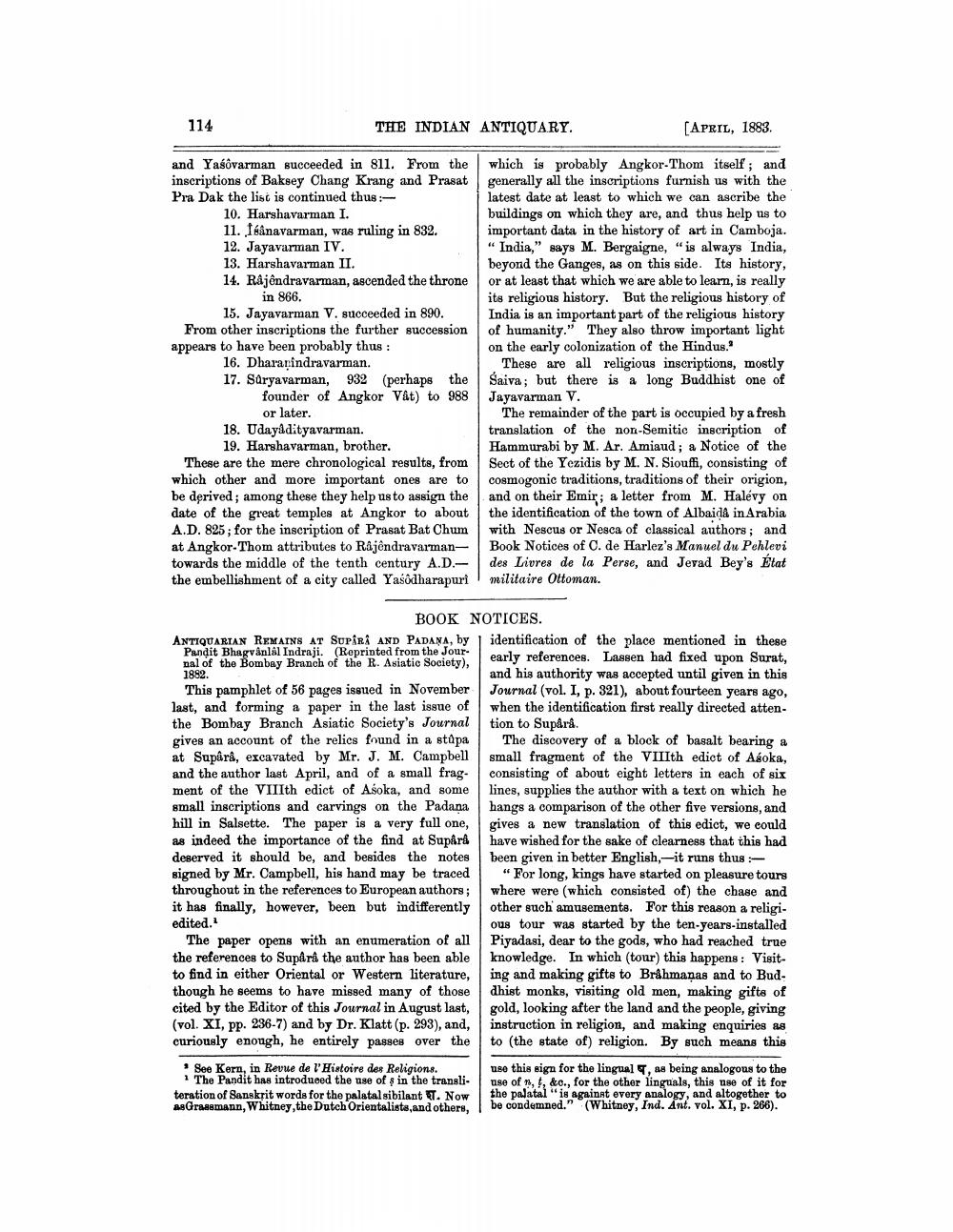________________
114
THE INDIAN ANTIQUARY.
[APRIL, 1883
and Yasovarman succeeded in 811. From the inscriptions of Baksey Chang Krang and Prasat Pra Dak the list is continued thus :
10. Harshavarman I. 11. Ibånavarman, was ruling in 832. 12. Jayavarman IV. 13. Harshavarman II. 14. Rajendravarman, ascended the throne
in 866. 15. Jayavarman V. succeeded in 890. From other inscriptions the further succession appears to have been probably thus :
16. Dhararindravarman. 17. Süryavarman, 932 (perhaps the
founder of Angkor Våt) to 988
or later. 18. Udayadityavarman.
19. Harshavarman, brother. These are the mere chronological results, from which other and more important ones are to be derived; among these they help us to assign the date of the great temples at Angkor to about A.D. 825; for the inscription of Prasat Bat Chum at Angkor Thom attributes to Rajendravarmantowards the middle of the tenth century A.D. the embellishment of a city called Yasôdharapuri
which is probably Angkor Thom itself; and generally all the inscriptions furnish us with the latest date at least to which we can ascribe the buildings on which they are, and thus help us to important data in the history of art in Camboja. " India," says M. Bergaigne, “is always India, beyond the Ganges, as on this side. Its history, or at least that which we are able to learn, is really its religious history. But the religious history of India is an important part of the religious history of humanity." They also throw important light on the early colonization of the Hindus."
These are all religious inscriptions, mostly Saiva; but there is a long Buddhist one of Jayavarman V.
The remainder of the part is occupied by a fresh translation of the non-Semitic inscription of Hammurabi by M. Ar. Amiaud; a Notice of the Sect of the Yezidis by M. N. Siouffi, consisting of cosmogonic traditions, traditions of their origion, and on their Emir; a letter from M. Halévy on the identification of the town of Albaida in Arabia with Nescus or Nesca of classical authors; and Book Notices of C. de Harlez's Manuel du Pehlevi des Livres de la Perse, and Jevad Bey's État militaire Ottoman.
BOOK NOTICES. ANTIQUARIAN REMAINS AT SUPRA AND PADANA, by identification of the place mentioned in these
Pandit Bhagvanlal Indraji. (Reprinted from the Journal of the Bombay Branch of the R. Asiatic Society),
early references. Lassen had fixed upon Surat, 1882.
and his authority was accepted until given in this This pamphlet of 56 pages issued in November Journal (vol. I, p. 321), about fourteen years ago, last, and forming a paper in the last issue of when the identification first really directed attenthe Bombay Branch Asiatic Society's Journal tion to Supårå. gives an account of the relics found in a stúpa The discovery of a block of basalt bearing a at Supârâ, excavated by Mr. J. M. Campbell small fragment of the VIIIth edict of Asoka, and the author last April, and of a small frag. consisting of about eight letters in each of six ment of the VIIIth edict of Asoka, and some lines, supplies the author with a text on which he small inscriptions and carvings on the Padana hangs a comparison of the other five versions, and hill in Salsette. The paper is a very full one, gives a new translation of this edict, we could as indeed the importance of the find at Supårå have wished for the sake of clearness that this had deserved it should be, and besides the notes been given in better English,-it runs thus :signed by Mr. Campbell, his hand may be traced "For long, kings have started on pleasure tours throughout in the references to European authors; | where were (which consisted of) the chase and it has finally, however, been but indifferently other such amusements. For this reason a religiedited.
ous tour was started by the ten-years-installed The paper opens with an enumeration of all Piyadasi, dear to the gods, who had reached true the references to Supârâ the author has been able knowledge. In which (tour) this happens : Visitto find in either Oriental or Western literature, ing and making gifts to Brahmaņas and to Budthough he seems to have missed many of those dhist monks, visiting old men, making gifts of cited by the Editor of this Journal in August last, gold, looking after the land and the people, giving (vol. XI, pp. 236-7) and by Dr. Klatt (p. 293), and, instruction in religion, and making enquiries as curiously enough, he entirely passes over the to the state of) religion. By such means this
See Kern, in Revue de l'Histoire des Religions. 1 The Pandit has introduced the use of in the transli teration of Sanskrit words for the palatal sibilant T. Now as Graumann, Whitney, the Dutch Orientalists and others,
use this sign for the lingual , as being analogous to the n se of , !, &c., for the other linguals, this use of it for the palatal "is against every analogy, and altogether to be condemned." (Whitney, Ind. Ant. vol. XI, p. 266).




